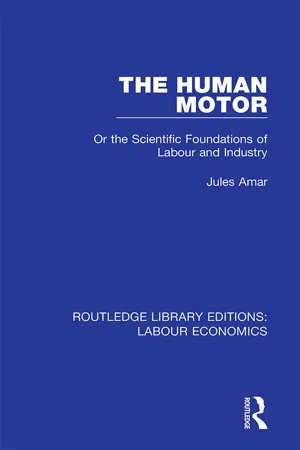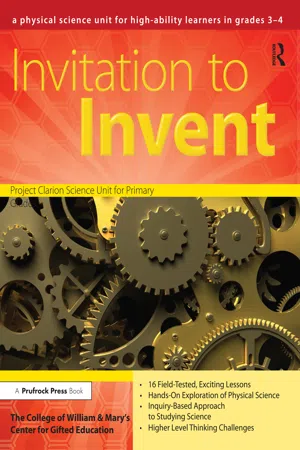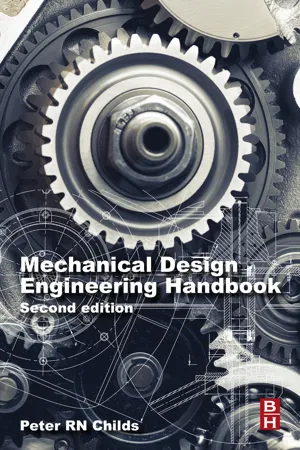Physics
Simple Machines
Simple machines are basic mechanical devices that can be used to multiply or change the direction of a force. They are the building blocks of more complex machines and are categorized into six types: lever, pulley, wheel and axle, inclined plane, wedge, and screw. These machines allow us to perform work with less effort by trading distance for force or force for distance.
Written by Perlego with AI-assistance
5 Key excerpts on "Simple Machines"
- eBook - ePub
Aviation Maintenance Technician Handbook—General (2024)
FAA-H-8083-30B
- (Author)
- 2023(Publication Date)
- Aviation Supplies & Academics, Inc.(Publisher)
- Machines are used to multiply force; for example, a system of pulleys may be used to lift a heavy load. The pulley system enables the load to be raised by exerting a force that is smaller than the weight of the load.
- Machines can be used to multiply speed. A good example is the bicycle, by which speed can be gained by exerting a greater force.
- Machines can be used to change the direction of a force. An example of this use is the flag hoist. A downward force on one side of the rope exerts an upward force on the other side, raising the flag toward the top of the pole.
There are only six Simple Machines. They are the lever, the pulley, the wheel and axle, the inclined plane, the screw, and the gear. Physicists, however, recognize only two basic principles in machines: the lever and the inclined plane. The pulley (block and tackle), the wheel and axle, and gears operate on the machine principle of the lever. The wedge and the screw use the principle of the inclined plane.An understanding of the principles of Simple Machines provides a necessary foundation for the study of compound machines, which are combinations of two or more Simple Machines.Mechanical Advantage of Machines
As identified in statements 3 and 4 under Simple Machines, a machine can be used to multiply force or to multiply speed. It cannot, however, multiply force and speed at the same time. In order to gain one force, it must lose the other force. To do otherwise would mean the machine has more power going out than coming in, and that is not possible.In reference to machines, mechanical advantage is a comparison of the output force to the input force, or the output distance to the input distance. If there is a mechanical advantage in terms of force, there will be a fractional disadvantage in terms of distance. The following formulas can be used to calculate mechanical advantage.Mechanical Advantage = Force Out ÷ Force In or Mechanical Advantage = Distance Out ÷ Distance InThe Lever
The simplest machine, and perhaps the most familiar one, is the lever. A seesaw is a familiar example of a lever, with two people sitting on either end of a board and a pivoting point in the middle. There are three basic parts in all levers. They are the fulcrum “F,” a force or effort “E,” and a resistance “R.” Shown in Figure 5-7 - eBook - ePub
The Human Motor
Or the Scientific Foundations of Labour and Industry
- Jules Amar(Author)
- 2018(Publication Date)
- Routledge(Publisher)
51. Simple Machines.—This name is given to the lever (fig. 84 ); to the inclined plane (fig. 88 ); to the pulley (fig. 92 ); to the hand winch (fig. 91 ); to the wedge (fig. 93 ), and the screw. The conditions of equilibrium of . these machines, under the forces which are applied to them, external forces and forces of restraint (§ 14), are given by an important theorem, that of Alembert relating to virtual work. If any point M of a system is displaced to M’ it is stated to produce work described as “virtual” to distinguish it from the real work that the forces could cause it to accomplish, for instance, in the direction MM” (fig. 83 ).FIG . 83.The theorem of Alembert says:“The necessary and sufficient condition for the equilibrium of a system is that for every virtual displacement of the system compatible with its connexions, the sum of the virtual work of the given forces shall be “zero.” But the work of the connexions, in the absence of any friction, is zero. Thus a point moving on a plane is subject to a reaction which, being perpendicular to the displacement, produces no work (§28). Therefore, it only remains to consider the work of the external forces which must also be zero, according to the theorem of Alembert. In fact, in an equilibriate system with connexions, it is known that all the forces have two resultants (§ 15), of which the work must be zero, because they are themselves both zero. As the virtual work of the one—that of the connexions—is zero, that of the other—the resultant of the external forces—must equally be zero. We apply this theorem to Simple Machines.FIG . 84.(1) Levers.—A lever is a rigid bar, movable round a fixed point called the fulcrum (A). The resistance, Q, to be overcome, is a force or weight applied at the extremity B of the lever and the power P is applied at the other extremity C (fig. 84 ). This type of lever is called a lever of the first order. But the resistance can be at the centre of the lever when it is said to be of the second order, or, finally, the power can be applied at the centre when it is said to be of the third order (fig. 85 - eBook - ePub
Invitation to Invent
A Physical Science Unit for High-Ability Learners (Grades 3-4)
- Clg Of William And Mary/Ctr Gift Ed(Author)
- 2021(Publication Date)
- Routledge(Publisher)
Instructional Time- 45 minutes
Systems Concept Generalizations
- Systems have parts (elements).
- Systems have boundaries.
- Systems have inputs and outputs.
- The interactions and outputs of a system change when its inputs, elements, or boundaries change.
Key Science Concepts
- Simple Machines are tools that make work easier.
- There are six different Simple Machines.
- Compound machines combine two or more Simple Machines.
- Motion is an object’s direction and speed.
- Changes in speed or direction of motion are caused by forces.
- Friction is a force that opposes motion.
- Moving objects have kinetic energy.
- Objects capable of kinetic energy due to their position have potential energy.
Scientific Investigation Skills and Processes
- Create meaning.
Assessment “Look Fors”
- Students can define motion, force, kinetic and potential energy, and friction and state examples.
- Students can apply the steps of the scientific process.
- Students can explain their invention.
Materials/Resources/Equipment
- PowerPoint slide, transparency, or chart of the Wheel of Scientific Investigation and Reasoning (Handout 3A )
- Copies of Handout 14A (My Invention Presentation Form), one per student
- Student log books
Implementing the Lesson
- Give students a copy of Handout 14A . Explain to them that they should work on their presentation while they are finishing up the work on their inventions. Once they have finished all of the fine-tuning on their inventions, they must be prepared to share their work. Point to the section of the Wheel of Scientific Investigation and Reasoning labeled Tell Others What Was Found. Engage students in a brief discussion about “telling others” using the following questions as a guide:
- Why do you think it is important to tell others about your work?
- How do scientists generally tell others?
- eBook - ePub
- Jeffrey W. Bloom(Author)
- 2010(Publication Date)
- Routledge(Publisher)
The following list provides more information about each of the Simple Machines.The set-up on the left side required much less effort on your part to lift the book. However, the set-up on the right side raised the book further. Although the mechanical advantage was higher with the left side set-up, it did not raise the book as far. As we’ll see soon, there are times when a lower mechanical advantage is better.1. An inclined plane , such as a ramp, allows one to apply less force to an object over a greater distance than lifting the object vertically. The smaller the angle of the inclined plane, the less force is needed to move an object up the inclined plane. In Figure 4.5 , an example of two inclined planes are shown. The ramp is the classic example, while the steps are less obvious, but they function as a “bumpy” ramp.2. A lever , such as a crow bar, bottle opener, shovel, or seesaw, is some sort of “arm” or extension that pivots or rotates around some point, which is called a fulcrum . Our arms and legs are levers with the fulcrums at the joints. If we want to move a huge rock on our lawn, we may not be able to move it with our bodies. However, if we put one end of a long steel pipe under the rock and then placed a brick or a smaller rock under the pipe near the huge rock we are trying to move, we can then push down on the other end of the pipe and lift the huge rock. The distance on each side of the fulcrum of the lever determines how much force is needed to push down on the lever. Figure 4.4 - eBook - ePub
- Peter Childs(Author)
- 2018(Publication Date)
- Butterworth-Heinemann(Publisher)
In a third-order lever, the force is between the fulcrum and the load. Mechanical advantage is reduced but the movement at the load point is increased.F e = F l L l /L e Serway and Jewett (2018)20.3 Pulleys
A pulley comprises one or more wheels running on shafts over which a rope has been looped in order to make lifting a load easier. A pulley is a class of device called a simple machine that enables force amplification in a manner similar to levers.In the case of a two-wheel pulley, Fig. 20.3 , the mass is supported by two strands of the rope. As you pull on the loose end of the rope, you only need to impart half the force of the load in order to lift it, but you will need to pull the loose end of the rope twice as far as the height through which the load is lifted. The term mechanical advantage is used to refer to how much a simple machine multiplies a force. For a two-wheel pulley, the mechanical advantage is two. Similarly with a four-wheel pulley, Fig. 20.4 , the mass is supported on four strands of rope, and you need to impart a force of one-quarter of the weight of the load in order to move it, although you will need to pull the loose end through a distance four times that of the height that the load is lifted. A four-wheel pulley provides a mechanical advantage of four.Fig. 20.3 Two-wheel pulley.Fig. 20.4 Four-wheel pulley.Although pulleys provide mechanical advantage, the actual energy required to move the load is slightly more than the potential energy associated with the change in elevation because of friction between the rope and pulley wheels. A wide variety of pulley configurations are possible, with a selection of these presented in Table 20.2 .Table 20.2 A selection of some pulley configurationsType of Pulley Example Characteristics Useful equations and references Single wheel This configuration reverses the direction of the lifting force. As you pull down, the mass will rise. F applied = F load Serway and Jewett (2018) Two wheels With two wheels, the mass is supported by two strands of rope. This configuration gives a mechanical advantage of two, and it is possible to lift the load with half the force of the load.
Index pages curate the most relevant extracts from our library of academic textbooks. They’ve been created using an in-house natural language model (NLM), each adding context and meaning to key research topics.
Explore more topic indexes
Explore more topic indexes
1 of 6
Explore more topic indexes
1 of 4




